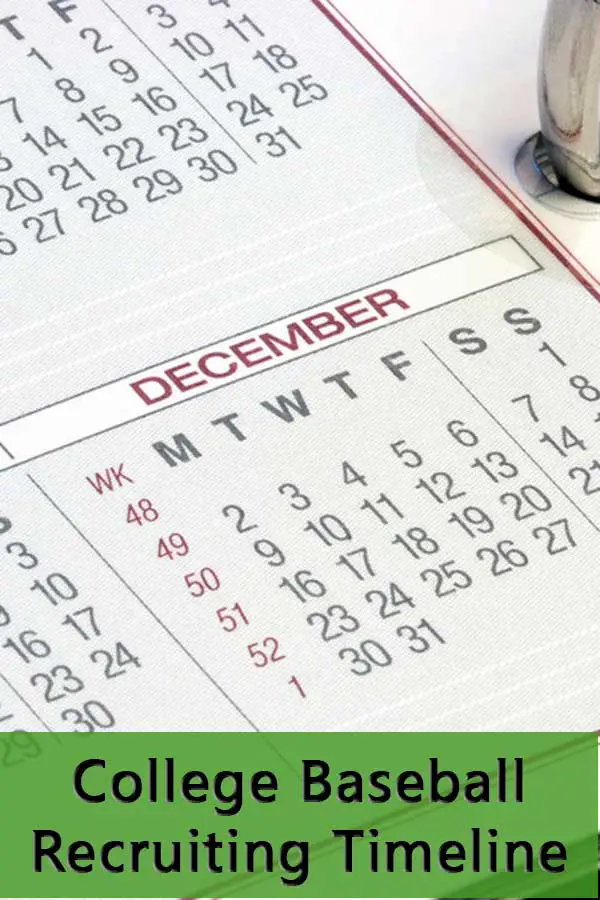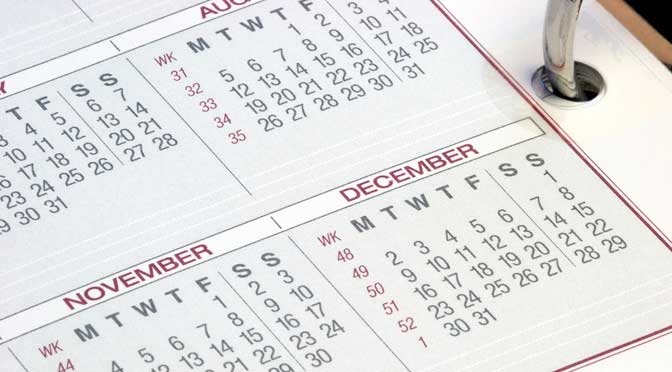 When looking at this recruiting timeline, keep in mind this is geared for baseball players. In many ways, your senior high school baseball season will not count. The majority of coaches (not all) will have already filled their recruit classes for the following year (your college freshman year). Depending on the division and conference (think “power 5”) they may have already filled the slots for the year after that (your college sophomore year) and only have a few left for the following year. Yes, college baseball coaches are taking verbal commitments from high school sophomores.
When looking at this recruiting timeline, keep in mind this is geared for baseball players. In many ways, your senior high school baseball season will not count. The majority of coaches (not all) will have already filled their recruit classes for the following year (your college freshman year). Depending on the division and conference (think “power 5”) they may have already filled the slots for the year after that (your college sophomore year) and only have a few left for the following year. Yes, college baseball coaches are taking verbal commitments from high school sophomores.
The thing to keep in mind with considering the college baseball recruiting timeline is that the MLB draft is a wildcard that can change everything. A player who is drafted higher than expected may decide to forego the college route leaving an opening with money in a D1 rooster. And don’t forget all the JuCo players that may or may not be transferring depending on how the draft works out for them.
So for those aiming for the most competitive conferences, you’re going to need to demonstrate your talent by your sophomore year. For the rest, you should still be able to be recruited based on your junior season and the following summer.
It is essential to see your high school timeline in relationship to the recruiting timelines for college coaches. What does this mean? Your senior season (for baseball) occurs too late to count. In most cases, you are going to have to submit your college applications before your season even starts.
If you think you’re good enough to expect a phone call from a coach on July 1 after your junior year, you’ll have to do more than just have an outstanding junior season of high school baseball. After all, it’s not likely the coach will have had time to watch you play while he’s in the middle of his season.
And while video helps (there are coaches who recruit off of video only), it’s the camps and tournaments you attended the summer before that will matter. They need to be events that the coach is following or familiar with to actually inspire a July 1 phone call. Furthermore, this assumes that you selected camps based on which coaches attend and follow.
This means that you have already targeted the schools you are interested in before your junior year!
Even if you think you’ll be competing at a lower level, you’ll still need your targeted list of schools by the end of your junior year. This is why it’s not unreasonable to start visiting colleges during your sophomore year and the summer before. (The DIY College Rankings Baseball Spreadsheet can help you create your list of targeted schools.)
The following is recruiting timeline for baseball. There are some things missing from this list that you’ll find on others. The two big ones are: keep up the academics and keep up your physical training. I think that these should be givens for your entire high school career and don’t see the need to repeat it in every section.
Depending of the level of colleges you’re targeting, everything can happen a year earlier.
College Baseball Recruiting Timeline
| Freshman |
|
SPRING |
|
Believe it or not, playing on your high school team is still an important part of the recruiting process. No, it’s not likely that college coaches will show up to your games. Rather, you should use the results of your high school freshman season to determine what level college to target.
If you’re potential D1 material, you should know by the end of your freshman season. The following are some signs:
- You played varsity as freshman
- Invitation to the USA Baseball National Team Development Program
- Invitation to the Area Code Underclass Tournament
- You’re playing on a nationally ranked travel team (Check places like Perfect Game to see where ranked teams play–does your team play in the same places)
The key is to be realistic about your abilities and potential for improvement. Remember, your chances of getting into Harvard are better than your chances of going pro. And playing college baseball is not the same thing as getting a scholarship.
- If you are shooting for a top D1 program, get video from your season to post.
|
| Sophomore |
|
SUMMER-RISING SOPHOMORE |
|
If you’re targeting the major D1 programs, you should also do items in Summer Rising Junior Year.
- Play on a summer team.
- If possible, attend a showcase or prospect camp to get an idea of what level you can play at in college. This is a perfect time to attend a prospect camp at a local college and use the college coach’s interest to estimate your ability level.
- Start visiting colleges, even if they are just local ones that you may not have much interest in. You need to develop a baseline from which to evaluate other schools.
- Look up the NCAA rules about contact with coaches and grade and ACT/SAT test scores requirements. This information is free and there is no excuse not to know the information.
- Decide if you want to use a professional service for recruiting college athletes or even just the college admissions process. You’ll get more value from these services the sooner you start using them.
|
|
FALL |
|
If you’re targeting the major D1 programs, you should also do items in Junior Fall.
- Take the PSAT if offered by your school. This is an easy and inexpensive way to gauge your probable SAT score.
- Make sure that your high school counselor knows that you’re interested in playing at the college level. You need to make sure that the classes you are taking will count toward NCAA requirements. (For homeschoolers, use the course titles of acceptable courses provided by the NCAA to minimize problems.)
|
|
SPRING |
|
- You should be playing on your high school team. Remember NCAA rules, coaches cannot initiate contact with you at this time. However, you can contact coaches at any time.
- Make sure you get video from your season to post.
|
| Junior |
|
SUMMER-RISING JUNIOR |
|
- Play on a summer team
- Start generating a list of potential schools. This could be as many as 50 schools. Don’t think that this is too many. Keep in mind that schools will start falling off the list for a variety of reasons: the coach isn’t interested; too many players at the position; you don’t like the coaching philosophy; the team has a low graduation rate; you don’t like the school; you won’t start; you don’t like the facilities; the team has a poor record; or you don’t have very good chances at getting admitted to the school.
- Attend showcases, ideally where some of the schools you are interested in are participating.
- Visit colleges whenever possible.
- Put together your athletic profile so it can be easily updated.
- Fill out the online recruiting form for all of the colleges you are interested in. Follow this up with an email with your athletic profile and a link to your video, if you have any.
|
|
FALL |
|
If you’re targeting the major D1 programs, you should also do items in Senior Fall. If you’re looking at making an early verbal commitment, you should definitely request a financial aid pre-read.
- Retake the PSAT. This allows you to qualify for the National Merit Scholarship program. Colleges will start sending you information based on your scores and there are a lot more academic scholarships than athletic scholarships.
- Take the SAT/ACT during the semester your sport is not in session. For baseball players this means the fall of your junior year. Coaches need to know your score to know if you have a chance at being accepted to their schools. You need to know your score so you can plan to retake the test if necessary.
- Subscribe to a service like BeRecruited.com. If nothing else, it will give you a place to post your video. Of course, you can post your video on YouTube but why not someplace where you already know coaches will be visiting?
- Register with the NCAA Eligibility Center.
- Start calling coaches to ask him what positions he will be looking for in your recruiting class.
- Attend fall visit days for colleges. Arrange for meetings with coaches whenever possible.
|
|
SPRING |
|
- Play on your high school team and get video. At the very least, invest in a stand to hold your camcorder or smartphone. You can then set it up and have it record the area of the player’s position during defense and move it for batting.Unless your son is playing pitcher or catcher, there will be a lot of useless video to edit out. Make sure you do edit the video to be no more than four minutes, ideally less than two. You can probably get an entire season of at bats in less than four minutes. It is not difficult to edit video. You can download a program as part of Microsoft Windows that will allow you to cut video, eliminate the sound (don’t add music!), and put a splash screen with the player name and information at the beginning.
- Send updates to coaches that you have already contacted. Let them know about a homerun, no-hitter, etc. Also, you can let them know when you have uploaded video. Don’t expect automatic replies since they will be in season as well. Try to use a consistent subject line for each contact, for example: John Smith, 201X Prospect, Update.
- If necessary, repeat the ACT/SAT for the final sitting of the semester. It will be one less thing to worry about your senior year. The June date is also a good time to take any required SAT subject tests. Request your transcripts be sent to the NCAA Eligibility Center at the end of the semester for a preliminary evaluation.
- Ask teachers if they will write letters of recommendation in the fall.
- End of the semester/beginning of summer, continue to call coaches and ask what they’re looking for in your recruit class.
|
| Senior |
|
SUMMER-RISING SENIOR |
|
- Play on summer team
- Attend camps with targeted schools attending
- Let targeted coaches now which camps you will be attending and summer schedule.
- Visit colleges. Schedule admissions interviews and meetings with coaches whenever possible.
- Work on any required college admissions essays.
|
|
FALL |
|
- Retake the SAT/ACT if necessary
- Schedule official and unofficial overnights (you should be familiar enough with the NCAA rules to know the difference)
- Get your financial aid form submitted as close to October 1 as possible.
- Submit college applications as soon as possible. If you have a first choice, talk with the coach about early decision.
- Make sure all of your letters of recommendation are submitted.
- For those getting scholarships, sign national letter of intent. For those targeting the Ivy League, try for a likely letter.
- Let college coaches that you have rejected know as soon as possible.
|
|
SPRING |
|
- Keep in contact with the coaches. Those that don’t give scholarships will understand that you need to know your financial aid situation at all the schools before you can make a decision.
- Request final transcripts to be sent to the NCAA.
- Once you accept at a school, get the team’s summer workout schedule and do it.
- Let college coaches that you have rejected know as soon as possible.
|

 When looking at this recruiting timeline, keep in mind this is geared for baseball players. In many ways, your senior high school baseball season will not count. The majority of coaches (not all) will have already filled their recruit classes for the following year (your college freshman year). Depending on the division and conference (think “power 5”) they may have already filled the slots for the year after that (your college sophomore year) and only have a few left for the following year. Yes, college baseball coaches are taking verbal commitments from high school sophomores.
When looking at this recruiting timeline, keep in mind this is geared for baseball players. In many ways, your senior high school baseball season will not count. The majority of coaches (not all) will have already filled their recruit classes for the following year (your college freshman year). Depending on the division and conference (think “power 5”) they may have already filled the slots for the year after that (your college sophomore year) and only have a few left for the following year. Yes, college baseball coaches are taking verbal commitments from high school sophomores. 


6 thoughts on “College Baseball Recruiting Timeline”